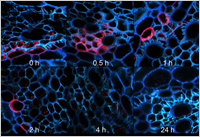Enlarge Image
How rice plants deal with environmental changes in manganese
Manganese (Mn) is an essential metal for the growth and development of plants but could also become toxic if accumulated in excessive amounts. However, the concentration of Mn in soil solution varies from sub-micromolar to hundreds of micromolar in rice fields. Therefore, rice plants must have a system to deal with such great changes of Mn.
Here, Naoki Yamaji and colleagues at Professor Jian Feng Ma's laboratory report the discovery that a transporter known as OsNramp3 functions as a switch in response to changes in the concentration of Mn in the environment. OsNramp3 is a plasma membrane-localized Mn transporter in the node of rice. At low Mn concentrations, OsNramp3 preferentially transports Mn to young leaves and panicles to meet the Mn requirement for growth. However, at high Mn concentrations, OsNramp3 protein rapidly degrades within few hours, resulting in an alternated distribution of Mn to old tissues although the mRNA level is unaffected by Mn level.
These results reveal the OsNramp3-mediated strategy of rice for adapting to a wide change of Mn concentrations in the environments.
Reference:
・Authors: Naoki Yamaji, Akimasa Sasaki, Ji Xing Xia, Kengo Yokosho and Jian Feng Ma
・Title of original paper: A node-based switch for preferential distribution of manganese in rice.
・Journal, volume, pages and year: Nat. Commun (2013).
・Digital Object Identifier (DOI): 4:2442 doi: 10.1038/ncomms3442
・Affiliations: Institute of Plant Science and Resources, Okayama University
・Department website: http://www.rib.okayama-u.ac.jp/plant.stress/index.html

